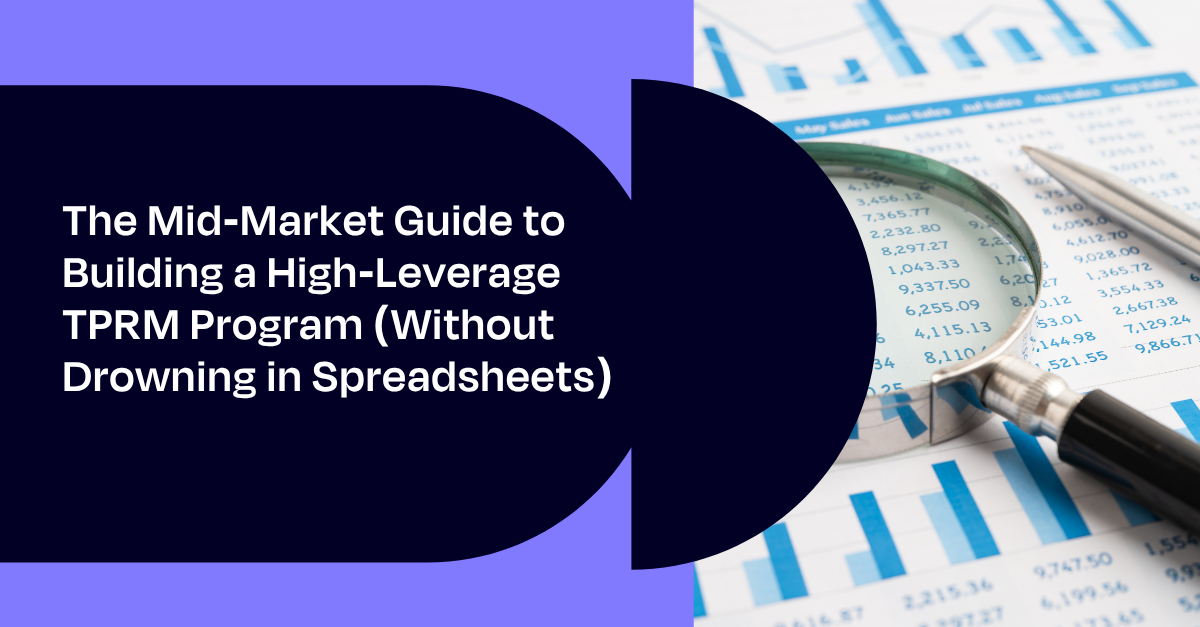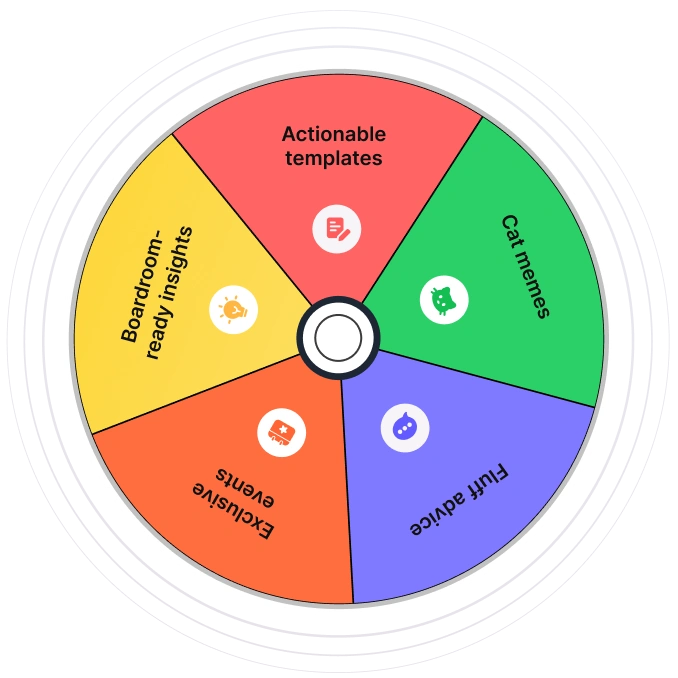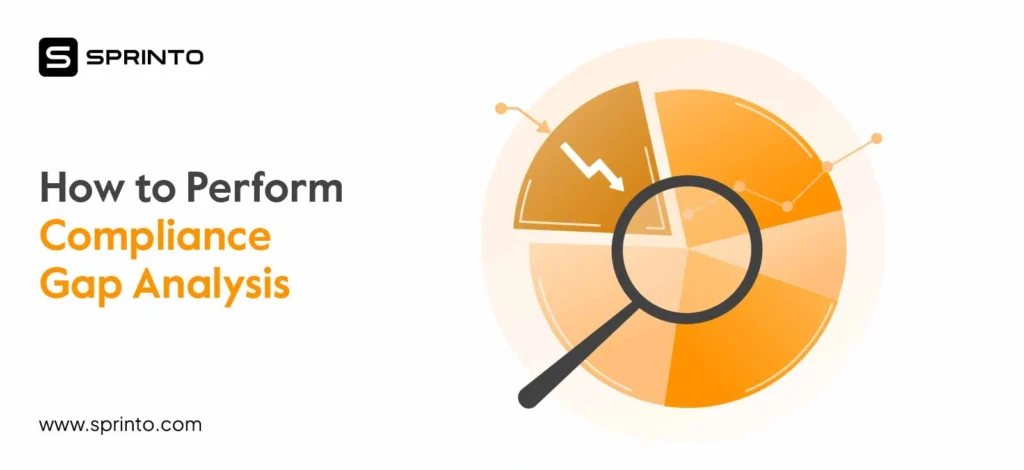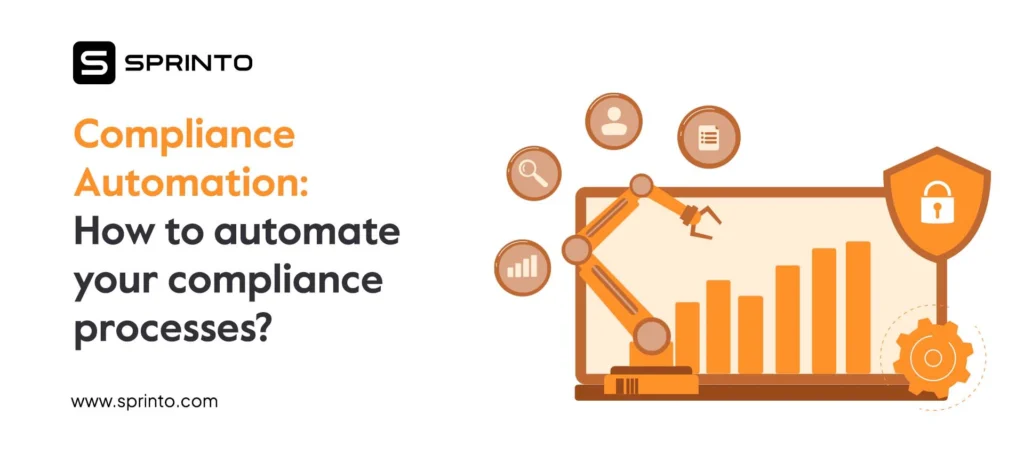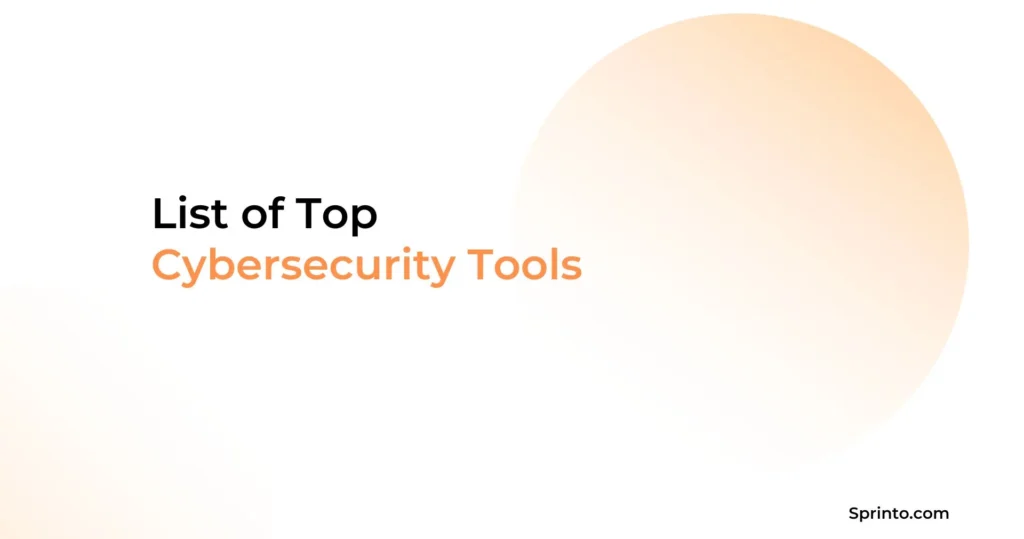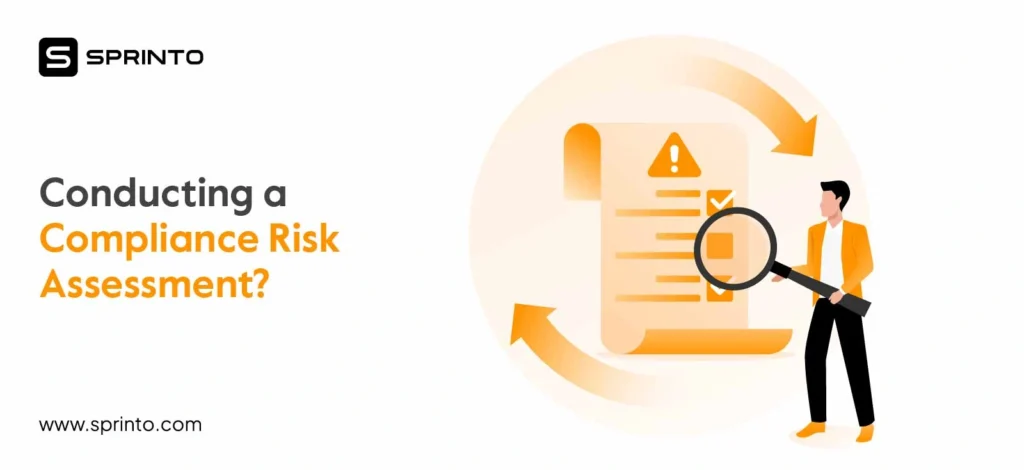As you attain and grow beyond mid-market status, you can’t scale a SaaS business on trust-me slides anymore. That’s because you’ll have increasing enterprise customers who will demand proof that your third parties are safe, resilient, and continuously verified. That means a TPRM (third-party relationship management program) lightweight enough for mid-market teams but rigorous enough for enterprise buyers and auditors.
This blog is a practical, MOFU-stage blueprint for Vendor Risk Managers, GRC leaders, CIOs, and CROs who need results in quarters, not years. We’ll cover a third-party risk management program, why it matters, what to include, how to build it step by step, and how to avoid classic pitfalls, like manual vendor risk assessments and audit fatigue from vendor compliance.
What is a TPRM Program?
A TPRM program is the set of policies, processes, and tooling you use to identify, assess, mitigate, and continuously monitor risks arising from third parties like vendors, partners, processors, and sub-processors who touch your data, infrastructure, or operations.
It spans all the vendor lifecycle stages, and typically includes the following stages:
1. Intake and scoping
This stage involves defining what is being purchased, why it is needed, and what systems or data the vendor will access. TPRM processes at this stage include documenting business and technical owners, identifying whether the vendor will touch production or non-production environments, and confirming that access is limited to what is necessary, typically read-only for sensitive systems such as production databases, S3 logs, or support tickets containing PII.
2. Due diligence
This stage includes structured reviews of the vendor’s security, privacy, and compliance posture. Typical activities include reviewing SOC 2 Type II or ISO 27001 reports, assessing recent pen-test results, confirming data storage locations, and ensuring appropriate Data Processing Agreements (DPAs) and sub-processor disclosures are in place.
3. Contracting
At this stage, the TPRM process ensures that required controls are captured in legal agreements. This typically covers breach-notification timelines, right-to-audit or third-party assurance, SLAs for uptime and incident response, and clear data-handling clauses such as data return or destruction.
4. Onboarding and monitoring
Once a vendor is approved, this stage involves implementing access controls, confirming least-privilege permissions, and tracking evidence of control implementation. TPRM processes here also include scheduling periodic reviews, setting alerts for incidents or changes to sub-processors, and applying continuous vendor monitoring for high-risk vendors.
5. Issue management
This includes maintaining records of any findings or control gaps identified during assessments. Typical actions include assigning owners, setting remediation deadlines, defining compensating controls, and verifying closure through evidence review. Exceptions are time-bound and re-evaluated regularly.
6. Offboarding
The final stage ensures clean separation when a vendor relationship ends. This involves disabling user and system access, verifying that company or customer data is returned or securely deleted, and capturing proof of deletion or confirmation of destruction for audit readiness.
Together, these stages produce a living, real-time record of each vendor’s risk profile, controls, and evidence, mapped to the frameworks your customers and auditors expect to see.
What you get in the end should be a living (that means real-time) dossier of risk, controls, and evidence for each vendor, mapped to the frameworks your buyers care about.
5 Reasons Why TPRM Programs Are Critical
A modern TPRM program doesn’t just tick regulatory checkboxes. It protects the pipeline, keeps regulators satisfied, and reduces incident fallout. Use these pillars to align teams and make the program measurable and repeatable.
- Prevents security review friction
Enterprise customers are judged on their vendor risk posture; you’re part of that chain. A credible TPRM process reduces friction in security reviews and accelerates deals. - Stays ahead of regulatory pressure
SOC 2, ISO 27001, PCI DSS, HIPAA, and GDPR expect a measured supplier risk approach. - Builds operational resilience
The breaches you don’t own still become your incident. TPRM contains blast radius (least privilege, tokenized data, contractual remedies). - Gives the board clearer visibility
Third-party risk is a standing item in enterprise risk reports. A structured program gives you defensible metrics rather than anecdotes. - Drives efficiency, not fire drills
Without process, every questionnaire is bespoke; every renewal, a brand new firefight. A standardized TPRM framework replaces chaos with repeatable, auditable steps.
Key Components of a TPRM Program
Before designing workflows, it makes sense to understand the key components, or foundational elements, of a TPRM program. These are the standard components in a mature TPRM program that typically tell you what exists, where it lives, and how each piece relates to the others. You can use this list of components as your inventory of “must-haves” so nothing gets invented ad hoc during procurement or audits.
Policy and standards
The written foundation that defines why the TPRM program exists and what it covers. It clarifies vendor in-scope definitions (vendors, partners, sub-processors), materiality thresholds (what makes a vendor “critical”), and baseline security and privacy expectations by risk tier. It also establishes ownership (who approves, who accepts risk) and references the controlling TPRM framework you align to (e.g., SOC 2 or ISO 27001 as the spine).
Vendor inventory
A centralized register of all third parties, including the business owner, technical owner, services provided, systems and data touched, geography, renewal dates, and current tier. It functions as the system of record for vendor lifecycle data and the anchor for audit artifacts.
Risk tiering
A classification model (commonly High/Medium/Low) informed by data sensitivity, privilege/access, and operational criticality. Tier determines the depth of diligence, reassessment cadence, approver seniority, and whether continuous vendor monitoring applies.
Due diligence Controls
The evidence model your third-party risk management program expects per tier includes external assurance (e.g., SOC 2 report, ISO 27001 certificate), technical artifacts (pen test summary, architecture notes, encryption details), and privacy/legal documentation (DPA, sub-processor list). This is the “what” you collect to substantiate control health.
Contract clauses
Security and privacy language embedded in MSAs/DPAs: breach notification timeframes, right-to-audit or independent assurance, uptime/availability commitments, sub-processor transparency and change notification, data return/destruction, and lawful transfer terms.
Issue and exception management
This is a formal record type for gaps discovered during diligence or monitoring (findings), plus time-boxed exceptions with compensating controls. It captures severity, ownership, planned remediation (CAPA), and closure evidence.
Monitoring and triggers
The mechanisms that keep posture current after onboarding: scheduled reassessments by tier and event-driven triggers for material changes (ownership, data flows, new sub-processors, region, incidents). For higher tiers, this may include continuous vendor monitoring signals.
Reporting and KPIs
A consistent set of measures for leadership and auditors: coverage by tier, median time-to-approve, percentage with current evidence, exception volume and age, renewal readiness, and concentration of risk across critical business functions.
Tooling and automation
The enabling platform and integrations (procurement, ticketing, IdP, finance, asset inventory) that orchestrate intake, questionnaires, reminders, expiries, artifact storage, and framework mappings, reducing manual vendor risk assessments and easing audit preparation.
TPRM Frameworks and Standards
You don’t have to reinvent criteria to run a credible TPRM program. Start with established standards, then right-size them for mid-market realities: fewer people, faster cycles, and buyer expectations anchored in familiar controls. Of course, as a mid-market company, you’ll need multiple frameworks, but you can cross-map the rest.
- SOC 2 (Trust Services Criteria): CC3, CC4, CC5 include vendor oversight; use SOC 2 language to satisfy enterprise buyers.
- ISO 27001 (Annex A & ISO 27036): Supplier relationships, information transfer, and cloud controls give you a solid baseline.
- NIST guidance (e.g., SP 800-53 SR controls, 800-161 for supply chain risk): Helpful for structuring due diligence in regulated contexts.
- PCI DSS (service provider oversight) and HIPAA (Business Associates): When you process cardholder data or PHI, these outline mandatory vendor safeguards.
- Shared Assessments (SIG/SIG Lite, VRMMM): A common language for questionnaires and program maturity.
- CSA STAR (for cloud providers): Useful signals when your vendors are cloud-native.
How to Set Up a TPRM Program (Step by Step)
Setting up and running your TPRM program should not feel like a mad scramble. You want a single process with well-defined criteria that moves vendors from request to review and decision in a steady, repeatable manner. Try these steps.
Step 1: Establish the program charter
Document objectives, scope boundaries, and decision rights. Select a primary TPRM framework (e.g., SOC 2 or ISO 27001) to use as your control spine and note any cross-maps you’ll maintain for customers and regulators.
Step 2: Build the vendor inventory
Aggregate vendors from procurement/AP, SaaS discovery, and IdP/SSO. Assign a business owner and technical owner per vendor. Record services, systems, data types, geography, and renewal dates in a single repository.
Step 3: Design your vendor tiering model
Define crisp criteria for marking vendors as high, medium and low risk using three levers: data sensitivity, access or privilege, and operational criticality. Validate the model with a small pilot and calibrate to keep the High tier intentionally narrow.
Step 4: Define evidence packs by tier
Create standardized “asks” per tier (e.g., SOC 2 Type II + pen test + DPA for High; SIG Lite + key policies for Medium; short attestation for Low). Map each artifact to your control spine so it’s reusable across customers and audits, minimizing audit fatigue from vendor compliance.
Step 5: Implement intake and routing
Publish a single intake form for new vendors. Automate routing to security, privacy, and legal based on tier and data categories. Preload due diligence requests and due dates when a vendor is submitted.
Step 6: Review, decide, and condition
Evaluate submissions against the evidence pack. Record findings and any required remediation. Approve, approve with conditions (time-boxed), or reject. Capture rationale in the system of record.
Step 7: Embed controls in contracts
Apply the right clauses by tier (notification windows, audit/assurance language, sub-processor transparency, data lifecycle obligations). Ensure redlines preserve minimum control expectations.
Step 8: Configure monitoring cadence & events
Set reassessment calendars by tier (e.g., High: annual plus event-driven). Establish triggers for material change. For high-risk vendors, connect continuous vendor monitoring where appropriate.
Step 9: Build remediation and exception workflows
Create templates for findings, CAPA tasks, and exceptions with expiry dates. Require evidence on closure and automatic escalation for overdue remediation actions.
Step 10: Operationalize reporting cadences
Publish a baseline dashboard (coverage, time-to-approve, evidence currency, exception age). Share a monthly snapshot with business leaders and a binder view for auditors. Use these outputs to inform quarterly planning and renewals.
Step 11: Test with a pilot. Iterate
Run the process with 10–20 representative vendors, measure cycle time and evidence completeness, then tune tier criteria, evidence packs, and SLAs before scaling.
See how NIUM scales TPRM and speeds enterprise security reviews. Read more.
Challenges in Running a TPRM Program
- Manual vendor risk assessments. Custom spreadsheets, ad-hoc Google Docs, and email ping-pong make every review expensive and error-prone.
- Signal vs noise. 200-question forms with yes/no answers don’t reveal actual control health. You need evidence, not just attestations.
- Velocity. Procurement and engineering need approvals in days; security wants diligence in weeks. Without automation, you either block the business or rubber-stamp.
- Coverage blind spots. Shadow IT, free tools, or contractors that slip past procurement.
- Renewal chaos. Certs expire; vendors change sub-processors; a new region triggers new obligations.
- Scaling pain. Each new framework (or big customer) adds a mapping exercise unless you start from a common control set.
Best Practices for Effective TPRM Programs
Once the program is live, you want to develop best practices that take you from “getting it done” to “getting it done with less effort and more signal.” The practices below focus on clarity, speed, and evidence quality, not on redefining the components or steps we’ve discussed thus far. Use them to reduce noise, accelerate approvals, and make your TPRM program a growth enabler rather than an administrative burden.
Anchor on one control language
Reduce translation debt by standardizing on a single control spine for your TPRM process (SOC 2 or ISO 27001) and maintaining a living cross-map. This lets you answer most customer questionnaires from one set of truths.
Minimize high-tier sprawl
Design your tiering so only truly material vendors land in High. Over-classification slows procurement and overloads analysts with low-value reviews. keep the High bucket narrow and intentional.
Prefer evidence with signal
Weight artifacts by reliability and freshness. Independent assurance (SOC 2 Type II period end within 12–18 months, ISO certificates within their validity), recent pen tests, and concrete architecture notes carry more signal than long self-attestations.
Separate decision rights from execution
Make business owners formally accountable for vendor risk, with Security/GRC as the control authority and facilitator. This keeps approvals tied to business impact and reduces the “security as the blocker” sentiments.
Design for renewal from day one
Capture expiry dates at intake, attach them to tasks automatically, and notify owners early. Most vendor due diligence challenges appear at renewal because the calendar wasn’t part of the design.
Instrument the workflow, not the people
Automate reminders, expiries, document requests, and status changes. Humans should judge risk and negotiate compensations, not chase PDFs. This directly reduces manual vendor risk assessments workload.
Create a findings economy
Not every gap warrants a stop sign. Use severities, compensating controls, and time-boxed exceptions with clear exit criteria. Track the “age of risk” as a first-class metric to prevent silent drift.
Show the business the payoff
Report revenue-adjacent metrics (time-to-approve critical vendors, % of renewals cleared before 30 days, questionnaire cycle time). When the business sees acceleration, adoption follows.
Run post-mortems on friction
For deals or renewals that stalled, hold a brief retrospective analysis: Was the evidence pack mismatched? Did contract language create churn? Did monitoring produce noisy alerts? Use this to refine templates and rules.
Continuously right-size
As your stack and customer base evolve, revisit tier thresholds, evidence packs, and monitoring coverage. A third-party risk management program is not “set and forget”.Iit should adapt with product, regions, and buyer expectations.
How Sprinto Supports TPRM Programs
Your team doesn’t have time to become a workflow shop. Sprinto gives you the building blocks to run a TPRM program that’s low-lift (but reliable), auditable, efficient, and buyer-friendly.
Unified vendor inventory
Keep one list for all vendors. Track owners, tiers, systems, data categories, and where data is stored. Pull entries from finance, SSO, and asset tools so you do not miss shadow vendors. Record validity and renewal dates for reports, policies, tests, and contracts. In Sprinto, maintain this as a single register with fields for tier, evidence on file, and upcoming renewals.
Intake and smart tiering
Use one intake form for every request. Classify vendors by data sensitivity, access level, and operational criticality. Attach a clear due diligence pack by tier so the depth of review is set from the start. In Sprinto, an intake form routes requests and applies tiering rules. The platform assigns the correct evidence requests automatically.
Due diligence workflows
Replace manual vendor risk assessments with standard, tier-based reviews. Ask for SOC 2, ISO 27001, pen tests, DPAs, and sub-processor lists as needed. Capture architecture notes and encryption details. Store artifacts with timestamps and ownership so you can trace who provided what and when. In Sprinto, reviewers request and store artifacts in the vendor record and log approvals and findings.
Evidence mapping across frameworks
Work from one control set. Map vendor evidence once and reuse it for SOC 2, ISO 27001, HIPAA, PCI DSS, and GDPR. This reduces duplicate requests and audit fatigue from vendor compliance. In Sprinto, map each artifact to multiple criteria so the same proof answers different framework questions.
Continuous monitoring hooks
Apply continuous vendor monitoring to high-risk vendors. Track attack surface changes, leaked credentials, and other posture signals. Use these signals to reopen reviews when risk changes, not only on a fixed calendar. In Sprinto, set event triggers that create a task or reassessment when a signal or material change is recorded.
Issue and exception management
Create findings directly from reviews. Assign an owner, due date, and compensating controls when needed. Require end dates on exceptions and send automatic reminders. Re-test and attach proof before closing. In Sprinto, findings, CAPA tasks, and exceptions live in the same workflow as the vendor record so you can see status at a glance.
Audit-ready reporting
Maintain a clear trail. For each vendor, show tier, requested evidence, received evidence, dates, approvals, and which criteria were met. Provide leaders a view of coverage, risk concentration, overdue findings, and upcoming renewals. Give auditors direct access to the exact records they request, time stamped and mapped to the relevant criteria. In Sprinto, dashboards and exports pull this directly from the vendor records and evidence store.
Security questionnaires done fast
Answer customer questionnaires from your vendor repository. Reuse policies, diagrams, and assurance reports. Link responses to the exact artifacts so reviewers can quickly verify. In Sprinto, pull responses from stored artifacts and map them to common questionnaire topics to speed reviews.
- Fewer meetings, fewer “status?” emails, fewer surprises at renewal.
- You spend time judging risk and improving controls, not chasing documents.
- When a buyer or auditor asks, your answers are consistent, backed by evidence, and mapped to the frameworks they recognize.
To sum up
A modern TPRM program is a business enabler. It makes procurement faster, sales smoother, and audits predictable, while actually reducing exposure from your vendor stack. The strategy is simple: standardize on a framework spine, right-size your tiering, insist on evidence, and automate everything calendar-driven. With Sprinto, you get those mechanics out of the box, so your team can deliver enterprise-grade assurance without the need for enterprise-grade headcount.
FAQs
1. What’s the difference between TPRM and vendor management?
Vendor management focuses on contracts, SLAs, and performance. TPRM zeroes in on security, compliance, privacy, and resilience risks, including how vendors access systems and data.
2. Which frameworks should I require from vendors?
For SaaS, SOC 2 Type II or ISO 27001 certification is a common baseline for high-risk vendors. Add pen tests, DPAs, and sub-processor transparency. In regulated contexts, require PCI DSS (card data) or HIPAA BAAs (PHI).
3. How often should I reassess vendors?
By tier: High (annual + event-driven), Medium (annual), Low (every 18–24 months). Always reassess on a material change (ownership, region, sub-processors, architecture).
4. Do I need continuous monitoring for every vendor?
No. Apply continuous vendor monitoring to high-risk vendors; for others, calendar-based reviews are sufficient. Focus your effort where potential impact is highest.
5. How do I avoid questionnaire bloat?
Use SIG Lite or a focused baseline aligned with your framework spine. Prefer real evidence (SOC 2, pen tests) over 300 yes/no questions. Make exceptions the exception.
6. What KPIs should I track?
Coverage by tier, median time-to-approve, % vendors with current evidence, #/age of open findings, exception count and expiry rate, % vendors mapped to frameworks relevant to your customers.
7. We’re small. Where do we start?
Start with inventory and tiering. Define the High-risk “ask” and a simple Medium/Low package. Then automate intake and expiries. You can layer on continuous monitoring later.
Sucheth
Sucheth is a Content Marketer at Sprinto. He focuses on simplifying topics around compliance, risk, and governance to help companies build stronger, more resilient security programs.
Explore more
research & insights curated to help you earn a seat at the table.



